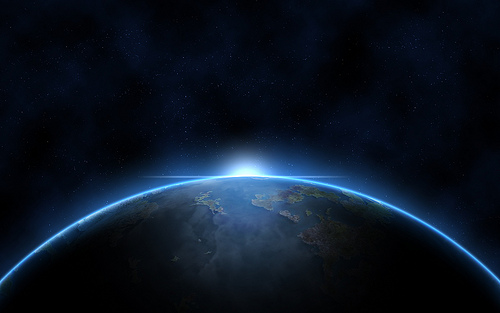When astronauts returned from the moon in 1969, they brought home with them photos of the earth.
Not only did this make possible the mass production of color images of the world, but ordinary people could also imagine themselves as those same astronauts reveling in the sublime sight of our blue-green planet. There is a sense in which those photos represented humanity’s first glimpse of itself in the mirror. For it was the first time we saw the world in all its splendor and constraints. And the frailty and beauty, the starkness and improbability, of that image spoke to us out of the vast firmament of emptiness.
But globes have been around for millennia now. History dates the first to the Greek scholar, Crates of Mallus, around 150 BCE. By that point Herodotus, the so-called “father of history,” had provided a study of the history and myths of the peoples of the Mediterranean and the ancient Near East. The problem was that the history and myths he reported were often difficult to distinguish from one another. For instance, the Phoenicians were said to have rounded the southern tip of Africa, but what this meant and whether or not it was true were not altogether clear.This wasn’t his fault. People simply lacked the ability at that time to clear up these sorts of issues. And because they lacked this ability, they didn’t tend to take these sorts of truth claims all that seriously. It would take a good couple of thousand years or so more before some of these questions were straightened out.
The oldest globe we now possess was made in Germany in the great historical pivot of 1492 C.E. At that moment there came to be a pressing need for globes, as traders and explorers fanned out across the oceans. But it was not as if a skilled carpenter of the fifteenth century could just carve away at a block of wood until a sphere emerged, then glue a map on it. The whole Western Hemisphere and much of Africa were not even recognized by the most educated Europeans of the time, and they had mapped far less than this with any recognizable degree of accuracy. Of the terrain that had been charted, it is difficult to imagine that it held much meaning. It may have been exotic and alluring perhaps, but it would have remained a curiously unpeopled image.
Rather humanity came to know the earth by degrees, blindly piecing together a puzzle for which no image yet existed. The circumference had to be calculated and a means of mapping longitude discovered, then the explorations and re-explorations that gave us our maps, then the fighting over the boundaries of those maps. It was not until hundreds of years later that something approaching the globes so many of us grew up with came into being. For hundreds of years more, our globes remained strikingly inaccurate. At about the same time the 1890 census declared the closing of the American frontier, the final explorations of the source of the Nile were just being completed.
Meanwhile, the whole interior of Papua New Guinea, with its two thousand languages and fifty thousand inhabitants, living in orderly terraced farming villages dating to the stone age, was not even discovered by outsiders until airplanes flew over it in 1938.
The earth as it was imagined just a couple of hundred years ago must have appeared more like a billiard ball than a bright blue marble. For it would have been barren of detail, like the abstractions of Newtonian physics and classical economics. And while it is primarily through the literary imagination that we might conceive of how the world as a whole was experienced throughout the modern era, it is revealing to note how seldom some depiction of the earth as a whole actually appeared in literature. Somehow a map or globe in the library may have been enough to move the imagination to the glories of exploration, like Marlow blindly placing a finger on the map to fix upon his destination in the Congo of Conrad’s, Heart of Darkness.
But the spinning of globes was rarely enough to move the heart to a love for the planet.
Yet there was a change of heart in the late sixties. In certain eco-spiritual subcultures, it is common to hear people suggest that the photos of the moon, or perhaps LSD, first awakened a love for the planet in mass culture. But this misses completely the magnitude of so many historical events of this era. In fact, the photos of the planet, and even the voyage from which they came, were merely a by-product of much deeper concerns.
The Apollo space project, after all, was part of a competition with the Soviets, whose first manned satellite and its implications of superior rocket technology, represented an existential threat to the whole of the western world. The newfound capacity to destroy the earth was so worrisome that it prompted the scientists who created the bomb to reverse course immediately after WWII was complete and to publish a critical book of essays, “One World or None.” Leading nuclear scientists like Andrei Sakharov in the U.S.S.R. and Robert Oppenheimer in the U.S. became the first anti-nuclear activists. When having risen through the Soviet ranks under Stalin, Nikita Khrushchev finally came to power and learned of the destructive potential of the Soviet nuclear arsenal in the mid-fifties, it so disturbed him that he could not sleep for several days. If the photos of the earth moved us in 1969, it seems more likely it was because the destruction of the planet through thermo-nuclear war appeared so immanent.
That impending sense of global peril, so accelerated and exacerbated by the Cold War, strengthened the role of post-war institutions like the United Nations, the World Bank, and the International Monetary Fund. For it was the purpose of these institutions to stabilize the international order, so as the threat intensified, they tended to become more active. These institutions grew in both size and importance as the post-war colonial empires rapidly disbanded and fragmented into states. During this time we saw the creation of the states of sub-Saharan Africa, India, Pakistan, Israel, and much of the Caribbean. Development became a priority for both the U.S. and the U.S.S.R., as they competed for influence in the once forgotten corners of the globe.
This competition brought proxy, and sometimes real, wars to remote lands like Guatemala, Angola, Zaire, Afghanistan, and Vietnam. Needless to say, these wars, and their potential for escalation, were a major concern to other nations. And for the first time, ordinary citizens began to conceive of a very concrete process through which the world as a whole might be destroyed.
Thus, the United Nations came to matter more and more, as international treaties and declarations initiated a slow build up to an international system. It was during this time that the world ceased to consist of exotic place names on maps and became a meaningful conglomeration of sovereign nation-states with unique cultures, economies, and institutions, all demanding attention. Educated people the world over came to understand them better, to be sure. But the ungoverned territories of the world also came to be consolidated under the management of states. It is remarkable the extent to which the post-colonial boundaries held. Somehow, the rising peoples and knowledge of the world had made every inch of this tiny sphere, spinning in a sea of darkness, matter.
And it is to this world, so fragile in its complexity, so stark and still, in its subtle majesty, that we now lend our allegiance. Somehow we have come to hold the world not only in our minds but in our hearts, like some dear friend for whom we are willing to sacrifice. We have all seen the videos now of cats and mice, lions and lambs, lying down together in love. Should it surprise us that we have come to love something so strange as a planet?
The above is excerpted from my book, Convergence: The Globalization of Mind.
Relephant:
The world isn’t even close to what you think it looks like.
Author: Theo Horesh
Editor: Renee Picard
Image: garysan97 at Flickr











Read 0 comments and reply